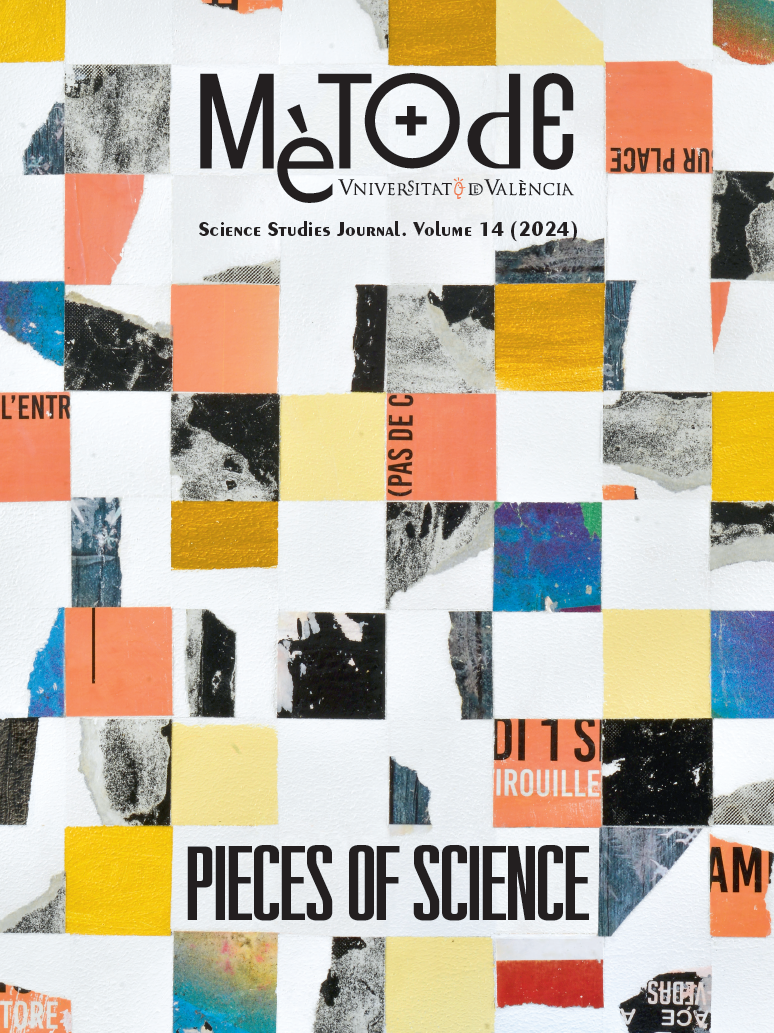Fotografia científica i astronomia: La tecnologia aplicada al coneixement de l’univers
DOI:
https://doi.org/10.7203/metode.14.24625Paraules clau:
astronomia, fotografia digital, llum, tecnologia, univers Resum
Resum
El 1925 Edwin Hubble va fer el primer pas per expandir en diversos ordres de magnitud la mida de l’univers conegut utilitzant els precaris mètodes fotogràfics disponibles: plaques de vidre amb emulsions fotosensibles. A través del registre de les fluctuacions periòdiques a la brillantor de certes estrelles (cefeides) mitjançant fotografies, Hubble va demostrar que la distància entre Andròmeda i la Terra era molt més gran del que es creia en aquella època. Andròmeda, fins aleshores considerada una nebulosa, devia ser en realitat una altra galàxia molt diferent de la nostra. De sobte, la mida estimada de l’univers va passar de centenars de milers d’anys llum a uns quants milers de milions d’anys llum. Des de llavors, la sinergia entre tecnologia fotogràfica i astronomia no ha deixat d’augmentar.
 Descàrregues
Descàrregues
 Referències
Referències
Benneke, B., Wong, I., Piaulet, C., Knutson, H. A., Lothringer, J., Morley, C. V, Crossfield, I. J. M., Gao, P., Greene, T. P., Dressing, C., Dragomir, D., Howard, A. W., McCullough, P. R., Kempton, E. M. R., Fortney, J., & Fraine, J. (2019). Water vapor and clouds on the habitable-zone sub-Neptune exoplanet K2-18b. The Astrophysical Journal Letters, 887(1), L14. https://doi.org/10.3847/2041-8213/ab59dc
Böker, T., Arribas, S., Lützgendorf, N., Alves de Oliveira, C., Beck, T. L., Birkmann, S., Bunker, A. J., Charlot, S., de Marchi, G., Ferruit, P., Giardino, G., Jakobsen, P., Kumari, N., López-Caniego, M., Maiolino, R., Manjavacas, E., Marston, A., Moseley, S. H., Muzerolle, J., … Zeidler, P. (2022). The near-infrared spectrograph (NIRSpec) on the James Webb Space Telescope. III. Integral-field spectroscopy. Astronomy & Astrophysics, 661, A82. https://doi.org/10.1051/0004-6361/202142589
Bryson, S., Kunimoto, M., Kopparapu, R. K., Coughlin, J. L., Borucki, W. J., Koch, D., Aguirre, V. S., Allen, C., Barentsen, G., Batalha, N. M., Berger, T., Boss, A., Buchhave, L. A., Burke, C. J., Caldwell, D. A., Campbell, J. R., Catanzarite, J., Chandrasekaran, H., Chaplin, W. J., … Zamudio, K. A. (2021). The occurrence of rocky habitable-zone planets around solar-like stars from Kepler data. The Astronomical Journal, 161(1), 36. https://doi.org/10.3847/1538-3881/abc418
Bunn, E. F., & Hogg, D. W. (2009). The kinematic origin of the cosmological redshift. American Journal of Physics, 77(8), 688–694. https://doi.org/10.1119/1.3129103
Cassinello Espinosa, A. (2019). La medida del cielo: Momentos estelares en las ciencias del cosmos. Escolar y Mayo Editores S. L.
Gardner, J. P., Mather, J. C., Clampin, M., Doyon, R., Greenhouse, M. A., Hammel, H. B., Hutchings, J. B., Jakobsen, P., Lilly, S. J., Long, K. S., Lunine, J. I., Mccaugherean, M. J., Mountain, M., Nella, J., Rieke, G. H., Rieke, M. J., Rix, H., Smith, E. P., Sonneborn, G., … Wright, G. S. (2006). The James Webb space telescope. Space Science Reviews, 123(4), 485–606. https://doi.org/10.1007/s11214-006-8315-7
Harrison, E. (1993). The redshift-distance and velocity-distance laws. The Astrophysical Journal, 403, 28–31.
Henden, A. A., Welch, D. L., Terrell, D., & Levine, S. E. (2009). The AAVSO photometric all-sky survey (APASS). American Astronomical Society Meeting Abstracts, 214, 402–407.
Hubble, E. (1929). A relation between distance and radial velocity among extra-galactic nebulae. Proceedings of the National Academy of Sciences, 15(3), 168–173. https://doi.org/10.1073/pnas.15.3.168
Hubble, E., & Humason, M. L. (1931). The velocity-distance relation among extra-galactic nebulae. The Astrophysical Journal, 74, 43–80. https://doi.org/10.1086/143323
Huggins, W., & Miller, W. A. (1864). On the spectra of some fixed stars. Philosophical Transactions of the Royal Society of London, 154, 413–445. https://doi.org/10.1098/rstl.1864.0012
Leavitt, H. S., & Pickering, E. C. (1912). Periods of 25 variable stars in the Small Magellanic Cloud. Harvard College Observatory Circular, 173, 1–3.
Libby-Roberts, J. E., Berta-Thompson, Z. K., Désert, J.-M., Masuda, K., Morley, C. V., Lopez, E. D., Deck, K. M., Fabrycky, D., Fortney, J. J., Line, M. R., Sanchis-Ojeda, R., & Winn, J. N. (2020). The featureless transmission spectra of two super-puff planets. The Astronomical Journal, 159(2), 57. https://doi.org/10.3847/1538-3881/ab5d36
Mayor, M., & Queloz, D. (1995). A Jupiter-mass companion to a solar-type star. Nature, 378(6555), 355–359. https://doi.org/10.1038/378355a0
Petigura, E. A., Howard, A. W., & Marcy, G. W. (2013). Prevalence of Earth-size planets orbiting Sun-like stars. Proceedings of the National Academy of Sciences of the United States of America, 110(48), 19273–19278. https://doi.org/10.1073/pnas.1319909110
Rossiter, M. W. (1980). “Women’s work” in science, 1880-1910. ISIS, 71(3), 381–398. https://doi.org/10.1086/352540
Shapley, H., & Curtis, H. D. (1921). The scale of the universe. Bulletin of the National Research Council, 2(11), 171–217. https://archive.org/details/scaleofuniverse00shap
Slipher, V. M. (1915). Spectrographic observations of nebulae. Popular Astronomy, 23, 21–24.
Taton, R., & Curtis, W. (1995). Planetary astronomy from the Renaissance to the rise of Astrophysics: Part B: The Eighteenth and Nineteenth centuries. Cambridge University Press.
Descàrregues
Publicades
Com citar
-
Resum938
-
PDF 146
Número
Secció
Llicència
![]()
Tots els documents inclosos en OJS són d'accés lliure i propietat dels seus autors.
Els autors que publiquen en aquesta revista estan d'acord amb els següents termes:
- Els autors conserven els drets d'autor i garanteixen a la revista el dret a la primera publicació del treball, llicenciat baix una llicència de Reconeixement-NoComercial-SenseObraDerivada 4.0 Internacional de Creative Commons, que permet a altres compartir el treball amb un reconeixement de l'autoria del treball i citant la publicació inicial en aquesta revista.
- Es permet i s'anima els autors a difondre la versió definitiva dels seus treballs electrònicament a través de pàgines personals i institucionals (repositoris institucionals, pàgines web personals o perfils a xarxes professionals o acadèmiques) una vegada publicat el treball.





